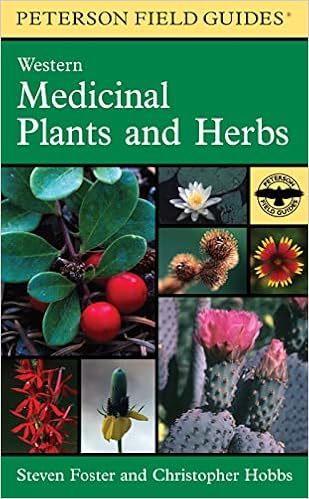
A Peterson Field Guide To Western Medicinal Plants And Herbs (Peterson Field Guides)
Paperback – April 18, 2002
Description
About the Author Christopher Hobbs, a licensed acupuncturist and herbalist, teacher, and consultant to the dietary supplement industry, has written many books on herbal medicine, including Herbs for Dummies and Dietary Supplements for Dummies . With more than 40 years of experience in the herbal field, Steven Foster is author, co-author, and photographer of seventeen books. He lives in Eureka Springs Arkansas, in the heart of the medicinal plant-rich Ozarks. Excerpt. © Reprinted by permission. All rights reserved. Miscellaneous Showy Flowers BUNCHBERRY Leaves, roots, berries Cornus canadensis L. Dogwood FamilyLow-growing, spreading perennial, 3–8 in., often forming large colonies. Oval leaves in whorls of 6 beneath showy “flowers” (bracts); veins arch from leaf base toward tip; margins entire. Small, greenish white flowers tightly clustered above 4 large, white, petallike bracts; May–July. Fruit scarlet, single-seeded. Where found: Moist, cool forests, meadows, bogs. Alaska to Idaho, Mont. south to N.M., nw. Calif. eastern N. America. Uses: American Indians toasted the leaves, then sprinkled the powder on sores. Berries were a snack source, dried and stored for winter; also chewed to treat insanity. Leaf tea drunk as a strong laxative and to treat paralysis. The Paiutes mashed and strained the roots and used the liquid as a wash for sore eyes. Tea of the whole plant was taken for coughs, fevers, and tuberculosis. Tea from roots, leaves, and berries was drunk for fits. A root tea was given to babies for colic. Bark tea drunk for body pains.ICE-PLANT, SEA FIG Leaves Mesembryanthemum crystallinum L. Carpet Weed FamilyMultibranched, bumpy-stemmed perennial, spreading along ground; to 24 in. high. Leaves succulent, alternate, flat, ovate to spoon-shaped; margins wavy. Flowers stalkless in leaf axils, showy, white to red- tinged, with many stamens and 5 linear petals; Mar.–Oct. Bumpy fruit opening when moist. Where found: Saline soils near coast, bluffs, disturbed sites, coastal sage scrub. Along the cen. and s. coast of Calif. to Ariz.; Baja Calif., Mexico; S. America, Mediterranean. Alien (South Africa). Uses: Historically, physicians used leaf juice to soothe inflammation of the mucous membranes of the respiratory or urinary system; to treat painful or difficult urination and involuntary urination. In Europe the fresh juice has been used to treat water retention and painful urination and to soothe lung inflammation. Related species: M. edule L. (Carpobrotus edulis [L.] N. E. Br.), or Hottentot Fig, a common escape in California, is used externally in S. Africa for burns and thrush and internally for dysentery. Warning: High in oxalates, potentially toxic in high doses, especially in flower and fruit.CANADA VIOLET Whole plant Viola canadensis L. Violet Family Perennial with short, thick rhizome and slender stolons; to 10 in. Leaves heart-shaped or oval on long stalks; tips pointed; margins toothed. Flowers solitary from leaf axils. Petals white above, purple beneath, yellow-centered; bottom petal dark-lined, spurred; side petals hairy at base; Apr.–July. Pod splitting into 3 valves. Where found: Moist to dry woods. Ore. to ne. Wash., Idaho, Utah, Ariz. Rockies from Mont. to N.M.; eastern N. America. Uses: Native Americans used a root tea for pains in the bladder region. Externally, a poultice was used to treat skin abrasions and boils. In European traditions violet species were listed as soothing and softening for coughs and colds, urinary tract ailments, and skin conditions. Warning: Roots of most if not all violet species may induce vomiting.Copyright © 2002 by Steven Foster and Christopher Hobbs. Reprinted by permission of Houghton Mifflin Company.
Features & Highlights
- The most complete guide ever written on the medicinal plants of western North America.
- Peterson Field Guide to Western Medicinal Plants and Herbs
- offers the best information in the world on the current popular and traditional uses of the nearly 500 species covered—much of it available for the first time.
- This comprehensive guide contains more than 530 color photographs that illustrate the plants and their flowers, leaves, and fruits; the descriptive text combines scientific, ethnobotanical, and cross-cultural information. What's more, the index to medical topics is helpful for quickly locating information on specific ailments, while symbols next to the plant descriptions provide quick visual warnings for poisonous and allergenic plants. Organized by flower color for fast identification, this guide is an essential aid to appreciating native plants and the wild areas they inhabit.
- For more than 85 years, Peterson Field Guides have set the standard by which other field guides are measured. Comprehensive and authoritative, they are essential additions to any naturalist's bookshelf or backpack.





